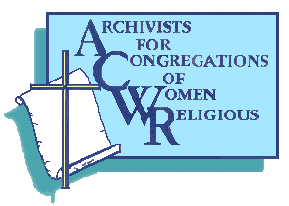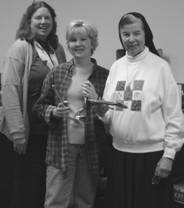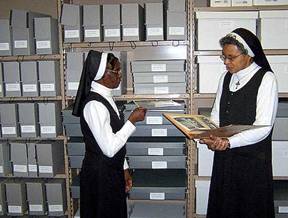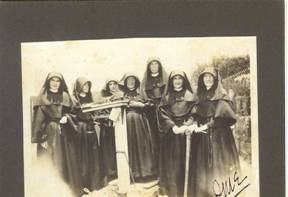|
|||||||
|
OPENING OF THE ARCHIVES OF
AN ARCHIVES MONTH CELEBRATION
|
In addition to St. Benedict’s Hospital, the sisters also conduced various schools, e.g. of Nursing, Medical Records, Laboratory, and X-ray. Students from these schools attended the open house, but frankly it appears they had more fun talking to each other than anything else. Significant credit must be given to Dr. Kathryn MacKay, history professor at Weber State University in Ogden, and Kathryn Burnside, former student and now a researcher, for their involvement in the project. In fact, the collaboration with Weber State University throughout the project was invaluable. The monastery also received a financial grant from the Utah State Historical Society. Without all this help, none of the above would have been possible.
Cornerstone of St. Benedict’s Hospital It might be mentioned, as a point of interest that one of the most “looked at” artifacts in the archives was the cornerstone of the original St. Benedict’s Hospital. Perhaps that is because it provided the stability which allowed the sisters, this year, to celebrate 60+ years in Utah.
Luke
Hoschette, OSB, archivist
|
||||||
|
|
|||||||
|
Kathryn MacKay, Ph., Kathryn Burnside, and S. Luke Hoschette getting ready for the Open House. October was Archives Month. Because of that, the sisters of Mount Benedict Monastery, Ogden, UT, had the grand opening of their monastery archives, the establishment of which had been in process for a number of years. The sisters have been in Utah since 1946 when they opened St. Benedict’s Hospital, which was their main ministry for over 20 years. On October 28, 2006, the formal opening of the archives was held at the monastery. A wonderfully written article on the front page of the local newspaper highlighted all the “goodies” that this unique archive contained – and perhaps because of that publicity, over 100 persons came. In addition to sharing the artifacts that were in the collection, the sisters wanted to share with the local community their history since 1946 when they came from Minnesota to open St. Benedict’s Hospital. Luke Hoschette, OSB, archivist for the monastery, had been diligent in saving written records and history. She also collected many artifacts which have significance since they may be the only record of some of the activities during that time. And the monastery was also fortunate to receive from interested persons many other items or memorabilia or records that enhanced what the archives finally contained. |
|||||||
|
AFTER THE HURRICANE During the three months after Hurricane Katrina while Dorothy Dawes, OP, was in evacuation, she was given gracious hospitality by the Franciscan Missionaries of Mary who have Our Lady of the Lake Hospital in Baton Rouge. While "pining" over the unknown fate of her archives in New Orleans, she eventually discovered an available computer, checked her accumulated email, and found a way to assist other Katrina-ravished archives. Meanwhile, Marie Richard Eckerle, SSND archivist, in Chatawa, MS. sent out an e-message to members of the Religious Community Archivists of Greater New Orleans, passing on information that the Society of American Archivists and the Society of Southwest Archivists were teaming up to offer grants of up to $2,000 for archivists who had suffered losses from Katrina that might be recovered.SAA and SSA announced the "creation of the SSA-SAA Emergency Disaster Assistance Grant Fund--established to address the stabilization and recovery needs of archival repositories directly affected by Hurricane Katrina. The practical nature of the use of grant monies was ideal: “monies may be used for the direct recovery of damaged or at-risk archival materials; such services as freeze drying, storage, transportation of materials, and rental facilities; supplies, including acid-free boxes and folders, storage cartons, cleaning materials, plastic milk crates, and protective gear; and to defray the costs for volunteers or other laborers who assist with the recovery.” The application process was wonderfully simple: one only had to give the mission of the repository; a brief description of archival collection(s); description of damage (with photographs if possible); amount of funding requested; a brief description of how the funds would be used; and any other sources of funding available to repository. Perhaps most helpful of all the criteria, the applicant did not have to be a "professional" archivist. In S. Dorothy's temporary "evacuation community" was a Sister Servant of Mary who was sadly lamenting the loss of her files, carefully saved for 30 years, documenting the history of their community, with its special ministry of nursing the sick in their homes never asking for any compensation.
|
The Irish Dominican Sisters from Cabra (greater Dublin) had also lost their whole collection of documents collected for the past 38 years. In another email from a member of the Greater New Orleans Archivists, S. Dorothy heard of the massive water damage to the archives of New Orleans' venerable City Park, and learned that the Williams Brothers, owners of Louisiana Binding, had evacuated to north Louisiana, and were working practically full time at recovery of water-damaged documents. They had been generous with her archives through the years, and she knew they could be trusted implicitly. Happily, the two sisters were approved for grants ($2,000 each). Mr. Pat Williams came on the same day to collect their soggy materials, and freeze-dried both in short order. There was understandably a time lag before they knew if anything could be salvaged. S. Dorothy was present during the Thanksgiving holiday when Pat Williams delivered the first ten acid-free boxes to the Irish sisters. The historian who had collected the documents had come from Ireland and brought them back with her, almost incredulous, and relieved. Ten more boxes have arrived since. A similar story was repeated with the nursing sister, a native of Columbia, who was overwhelmed with gratitude for what she considered a miracle. S. Dorothy has always 1) urged her fellow local archivists to join and participate in their professional associations, and felt amply rewarded. 2) remembered learning from two different researchers/ historians to never discount the value of small, "unofficial" archival collections. 3) In addition, she has acknowledged that she has a distinct call to bring together needs and resources, so this was one of the happiest outcomes of her three months in (painful) exile from her own work. She also notes that the two associations are to be commended for making the grants available by minimizing the formal criteria and the red tape. More deserving applicants could hardly have been found.
Dorothy
Dawes, OP Ed. Note. Grants are still available. Go to the SAA website www.archivists.org and click on SSA-SAA Emergency Disaster Fund to donate or to apply |
||||||
LETTER FROM THE PRESIDENTDear ACWR members, We’ve had a busy few months since the last newsletter. The National Office is in Cincinnati with a new Executive Secretary. Updates on the ACWR website provide more information and resources for members (www.archivistsacwr.org); this newsletter is on the Web page, allowing for more articles and pictures. The up-dated membership directory was mailed, and we’ve made a preliminary effort to notify members of events by e-mail. Your Board has initiated plans for the ACWR conference in 2009 and after our meeting in mid-May, we hope to be able to announce the site for the conference. In our move from the Washington, DC, office, Mary Hayes, SNDdeN, from Trinity University, was particularly helpful as Judy Metz, SC, and I sorted files, packed boxes and decided where the accumulated items should go. Without S. Mary’s help and hospitality, we would never have been able to accomplish everything in two days! S. Judy has been very generous with her time (as well as space) to help Lisa Raney, the new secretary, get adjusted to the work of the office. Many of you have been generous with sending in articles for the newsletter, responding to requests to serve as mentors, and thanking us for various services.
|
Of great concern, however, is the fact that in spite of many calls and requests by the Board, election committee, and other members, NO ONE was willing to put in her name for vice-president/president-elect! I actually considered leaving a big blank space in the newsletter with the caption- “This is a picture of the new ACWR vice-president”!!!! Certainly, all of the many people contacted did have valid reasons, but we do have a serious problem. The Board hoped that with the recent conference, our attempt to convince you we have a great group to work with, that structure of vice-president, president, and past-president as well as a secretary and treasurer, and the Executive secretary does help to spread the work around. We know perhaps a third of our membership is new each time; that many of the qualified people have many other tasks, particularly with mergers and special projects; and that others have served before. So, what to do?? The Board will try to resolve this at the May Board meeting, but we welcome your suggestions! The ACWR by-laws do allow us to make some adjustments; however, the normal process is for the new person to be oriented at the spring meeting and take office at the August meeting during the SAA conference. Please consider what you can do to support your wonderful organization! Thanks, Mary Denis Maher, CSA, president |
||||||
|
LCWR HISTORY EXHIBIT Planning and fund-raising for the proposed exhibit, “Pioneers, Poets & Prophets: Catholic Sisters in America,” continues at a fast pace. Since I shared information with you at the ACWR meeting at Ft. Mitchell in September, LCWR concluded a contract with Design Island for exhibit design purposes. The request for “Specific Artifacts” sent to archivists in March was a direct follow-up from a meeting with the designers at their Orlando, Florida offices in late February. The design specialists are learning a lot about religious life thanks to the work of the committee and your generous response from your archives. Preliminary ideas, sketches, and the artifacts themselves hold great promise for an exciting and inspiring exhibit. The target opening date and venue remain Women’s History Month, March, 2009, at the Smithsonian. Karen Kennelly, CSJ kkennelly33@hotmail.com |
FOR THE FEAST OF ANGELA: Just twenty years after Angela’s death, attempts to procure her canonization began in Brescia; but it was not until 1768 that she was officially declared Blessed. Thirty-nine years after that, on May 24, 1807, Angela Merici was canonized. She received the title of saint, and all the honors that go with it. Saint Angela Merici, from that day on, has been offered to the Universal Church for the reverence and imitation of the faithful. The woman who devoted much of her life to beginning a vast movement for the education and general welfare of women deserves the homage and the love of all who benefit from her work. (From The First Ursuline)
Colette Livingston, OSU
|
||||||
|
IOWA CONFERENCE OF ARCHIVISTS OF CATHOLIC INSTITUTIONS |
Anita Therese
Hayes, BVM |
||||||
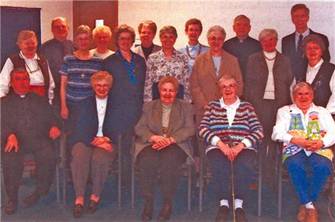 |
|||||||
|
1st Row:
Rev. Gerald Dolan, Anita Therese Hayes, BVM,
|
|||||||
|
SISTERS IN HEALTHCARE HISTORY PROJECT UPDATE |
According to Dr. Bavaro, there have been many wonderful and positive “spin-offs” related to the project. Some of these have included invitations to the Sisters to: present workshops and conferences during key University events, such as School of Business Week and Women in History Month (“Pioneer Women: Movers, Shakers, and Doers”); guest lectures in academic courses in political science, business, women’s studies, and sociology; presentation at Lambda Tau, the University’s Chapter of Sigma Theta Tau, the International Nursing Honorary Society; and explorations of volunteer opportunities for students, faculty, and staff of the University to work with the Sisters in their current ministries. In addition, some of the congregations have also begun to create oral histories for their communities as part of the project’s partnership with Edinboro University’s Oral History Center. Edinboro University is one of the sister institutions of Slippery Rock University. The Sisters’ most recent involvement in the life of the campus community was in April as part of the University’s Women as Activists Month sponsored by the Women’s Studies Department. Louise Grundish, SC, Michelle Grgurich, VSC, and Jeanette Bussen, CSJ, presented information on current ministries such as People Against the Trafficking of Humans (PATH). Dr. Bavaro feels that this will be an excellent opportunity for the Sisters to talk about their current ministries and how (and why) these have changed from the more traditional ministries of healthcare showcased in the project. It will provide an opportunity to show that Sisters continue to remain active and responsive to the needs of today’s people. For more information about the project, please contact Dr. Bavaro at john.bavaro@sru.edu
|
||||||
|
|
|||||||
|
L to R: S. Marguerite Coyne, CSJ, S. Anne Krull, VSC, S. Louise Grundish, SC presented "Pioneer Women: Movers, Shakers, and Doers" to a packed auditorium as part of SRU's Women in History Month last March. The Sisters in Healthcare History Project, which showcases the contributions to healthcare made by sixteen congregations of women over 160 years in Western Pennsylvania, is progressing well, according to the project’s coordinator, Dr. John A. Bavaro. The project is being developed by Slippery Rock University of Pennsylvania. One of the fourteen exhibits, which will travel throughout various venues, is now in the construction phase with a targeted opening date of late fall 2007. Descriptions of the project have been previously presented in this publication and can be seen by visiting their website at: http:///www.srshistoryproject.org.
|
|||||||
|
CORRECTIONS TO 2006-07 MEMBERSHIP DIRECTORY ACWR would like to apologize for omissions and mistakes found in the 2006-07 directory. There have also been a number of renewals. The corrections are as follows: Esther
Aherne OP
Dorothy
Anhaiser IWBD
Mary C.
Gaynor FSP
Anita
Janvier CCSJ
|
Donna
Marie Kessler OSF
Mary
Lauranne Lifka BVM
Kathleen
O’Connor If your entry in the Membership Directory needs corrections made or is missing altogether, please e-mail Lisa Raney at acwr@juno.com
|
||||||
|
IMAGES AND ARCHIVES |
The completion of the project has already proved to be a valuable asset in historical research. For example, in February 2006, Dr. Marilyn Richardson contacted the Archives requesting information on a statue that nineteenth century African American sculptor Edmonia Lewis sculpted and gave to the Oblate Sisters of Providence in the 1870s. While the statue apparently no longer exists, the archivist was able to find several pictures of the statue by using the completed photograph finding aid and database. Dr. Gloria Allen, a nineteenth century material culture expert, who is currently writing a book and lecturing on needlework done by Maryland school girls, made use of the finding aid and database in her search for examples of needlework, student photographs, and award ceremonies. Archivist Sharon Knecht uses the finding aid and database frequently when filling requests from researchers doing displays and exhibits on the mission work in parishes and schools around the United States. Because of Dr. Allen’s presentations about St. Frances Academy student needlework the Archives has received donations which allowed for some needlepoint preservation. Dr. Jalane Schmidt came to the archives to view the photographs of the Cuban missions. She will be using a number of the photographs as support research for her upcoming book Cuba and the Politics of Festivity: Our Lady of Charity in the Nation’s Streets. These are just a few examples of the importance of photographs as part of the historical record. The most significant impact the project had to date was to inspire the Oblate Sisters of Providence Council to approve the publication of a pictorial history of the Oblate Sisters of Providence. This would not be possible without a finding aid for the photograph collection. In turn if the NHPRC had not provided funding for the project most likely the photographs and scrapbooks would still be in a scattered array of places and virtually unavailable for research or further projects. Sharon Knecht, OSP archivist, authored the upcoming book, Oblate Sisters of Providence, a Pictorial History, which is scheduled to available for sale in June 2007. Funding for the printing of the first 1000 books was secured from a benefactor who is interested in supporting important historical issues as race, sex, religion, ethnic culture, child social welfare, African American social and religious history, and the history of women and children. The Oblate Sisters of Providence photograph collection and the resulting book illuminates all those themes. Sharon Knecht, OSP archivist osparchives@oblatesisters.com |
||||||
|
|
|||||||
|
Felicia Avila, OSP and Constance Fenwick, OSP examine images in the Oblate Sisters of Providence Historical Photograph Collection. The Oblate Sisters of Providence is the oldest sustained order of women religious of African descent in the world. The order was founded in Baltimore, Maryland in 1829 with the mandate of teaching and caring for African-American children. The Oblates’ first school, St. Frances Academy, opened in 1828 and is still educating children in Baltimore City. The OSP Archives contains a significant photograph collection which documents the history of the order as it grew to have missions in eighteen states, Cuba, Costa Rica, and the Dominican Republic. The OSP photograph collection provides a variety of opportunities to support research and illuminate in publications and exhibitions such important historical issues as race, sex, religion, ethnic culture, child social welfare, African American social and religious history, and the history of women and children. In 2003 a grant application was submitted to the National Historic Publications and Records Commission (NHPRC) to arrange, preserve, and make accessible for public use the estimated over 15,000 images in the Oblate Sisters of Providence (OSP) photograph collection dating from the 1850s. The archive was awarded the grant in 2004 and the work was finished in the spring of 2006. The completed project produced a hard copy finding aid, an electronic finding aid, and a searchable database, as well as preserving the images in archival sleeves and boxes. The finished project assists researchers to locate photographs that will enhance and illuminate the written records of the Oblate Sisters of Providence and their mission of educating and caring for children.
|
|||||||
WAYS SCHOLARS HAVE USED |
Loretto Academy, Las Cruces, New Mexico. Note the veils and the pins on the habit of the hearts of Jesus Suffering and of Mary Sorrowful. |
||||||
|
|
|||||||
|
A Loretto Sister with the Chinese children Every time someone asks to use our archives, I am pleased. We are blessed by the work of sisters who gathered Loretto’s early history, and kept it to be organized by trained personnel. A wide variety of sources were available to Patricia Jean Manion, SL, as she began work on Venture into the Unknown: Loretto in China 1923-1998. Many items were used: letters back and forth from the Sisters in China to the Loretto Superior General; memoirs written by each Sister; scrapbooks with newspaper articles, photos, drawings, etc; hundreds of photos covering street scenes in Hanyang, and Shanghai, the compounds where the Sisters lived, the classrooms, the convent-school buildings, ads for the school openings, and war scenes of bombings and refugees. Items brought back from China: prisoner of war badges the sisters wore, handmade, embroidered vestments, altar cloths, wall hangings, etc. Interviews were held with the Sisters when they returned from China. Another aspect of preparing this book was the cooperation and collaboration S. Patricia Jean was able to do with other religious congregations’ archives: Canossian Sisters in Hong Kong, Columban Priests in both Ireland and the United States, Columban Sisters in Ireland, Maryknoll Missions in New York, and Sisters of Charity of Mt. St. Joseph, Ohio.
|
Some other interesting topics researched are: early Catholic academies in Kentucky and how they compared with those on the East coast which were held up as models; Loretto Academy, Las Cruces, New Mexico 1870-1943 by a college student who took on the persona of one of the Sisters in a “1936 Hooverville Living History Exhibit”; spirituality of the early Sisters of Loretto (Friends of Mary at the Foot of the Cross) 1812-1850 via: Father Nerinckx’s instructions to early sisters on prayer, poverty, community; his handwritten rule of 1812; memoirs of several early sisters; and other writings. Researchers are welcome with a pre-arranged appointment. - - - - - - - - - - - - - - - If you wish to purchase a copy of Venture into the Unknown, make a check out to Sisters of Loretto for $20 (which includes postage), and mail to:
China Book
Kate Misbauer SL
|
||||||
|
ANNOUNCEMENT Mary Louise Sahm, SFP, has submitted her resignation as Secretary for the ACWR Board, due to impending knee surgery and the need to reduce her work load. She regrets the need to do this and asks your prayers. Obviously, we will need to elect another secretary. S. Mary Louise has served since Sept. 2006. |
SAVE THE DATE ACWR will have its annual meeting on Wed., Aug. 29, from 1-4 pm. during the SAA conference in Chicago. The room will be listed in your SAA program. Our agenda and program will be posted on the ACWR web site in the summer. Content Editor: Mary Denis Maher, CSA Production Editor: Lisa Raney |
||||||
|
. |
|
||||||
